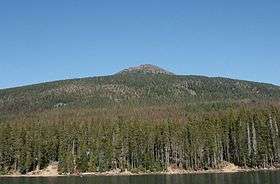Olallie Butte
| Olallie Butte | |
|---|---|
 Olallie Butte from the south | |
| Highest point | |
| Elevation | 7,219 ft (2,200 m) [1] |
| Prominence | 2,275 ft (693 m) [2] |
| Coordinates | 44°49′14″N 121°45′49″W / 44.8206738°N 121.7636815°WCoordinates: 44°49′14″N 121°45′49″W / 44.8206738°N 121.7636815°W [3] |
| Geography | |
| Location | Jefferson, Marion and Wasco counties, Oregon, U.S.[3] |
| Parent range | Cascades |
| Topo map | USGS Olallie Butte[3] |
| Geology | |
| Age of rock | Pleistocene[4] |
| Mountain type | Shield volcano |
| Volcanic arc | Cascade Volcanic Arc[4] |
| Last eruption | more than 25,000 years ago[4] |
| Climbing | |
| Easiest route | Trail[5] |
Olallie Butte is a steep-sided shield volcano in the Cascade Range of northern Oregon. It is the largest volcano and highest point in the 50-mile (80 km) distance between Mount Hood and Mount Jefferson, Oregon's two highest peaks. Ice Age glaciers carved two large cirques into the northeast and southeast flanks of the mountain exposing magma which hardened in the volcano's conduits to form the numerous spectacular pinnacles now found in the higher parts of the cirques.
A Forest Service fire lookout tower was built on the summit in 1920, but abandoned in 1967. The collapsed timbers of the lookout tower still remain on the summit to this day. A wedge-shaped piece of land including the summit area which had been part of the Willamette National Forest was ceded to the Warm Springs Indian Reservation under a revised interpretation of a 19th-century treaty. Most of Olallie Butte except the lower western flank now lies within the reservation. Although official maintenance of the 4-mile (6.4 km) trail to the summit also ended in the 1960s it still remains passable to hikers.
The summit of Olallie Butte is located on the border between Marion County and Jefferson County. The highest point in Wasco County is located at about 6,280 feet (1,910 m) in the northeast cirque. Olallie Butte overlooks the Olallie Scenic Area to the south which includes Olallie Lake. The term Olallie is Chinook Jargon for berry which are abundant in the area.[6]
.jpg)
References
- ↑ "Olallie". NGS data sheet. U.S. National Geodetic Survey. Retrieved 2008-04-01.
- ↑ "Olallie Butte, Oregon". Peakbagger.com. Retrieved 2008-04-01.
- 1 2 3 "Olallie Butte". Geographic Names Information System. United States Geological Survey. 1980-11-28. Retrieved 2014-12-13.
- 1 2 3 Wood, Charles A.; Kienle, Jűrgen (1993). Volcanoes of North America. Cambridge University Press. pp. 176–177. ISBN 0-521-43811-X.
- ↑ Grubbs, Bruce (1999). Hiking Oregon's Central Cascades. Helena, Montana: Falcon Press. pp. 30–31. ISBN 978-1-56044-873-0.
- ↑ "Indian names given to spots in mid-Oregon". The Bulletin. Aug 20, 1952. p. 2. Retrieved 14 October 2015.
- Harris, Stephen L. (2005). Fire Mountains of the West: The Cascade and Mono Lake Volcanoes (3rd ed.). Mountain Press Publishing Company. ISBN 0-87842-511-X.
- Kresek, Ray (1998). Fire Lookouts of the Northwest (3rd ed.). Historic Lookout Project. ISBN 0-87770-632-8.